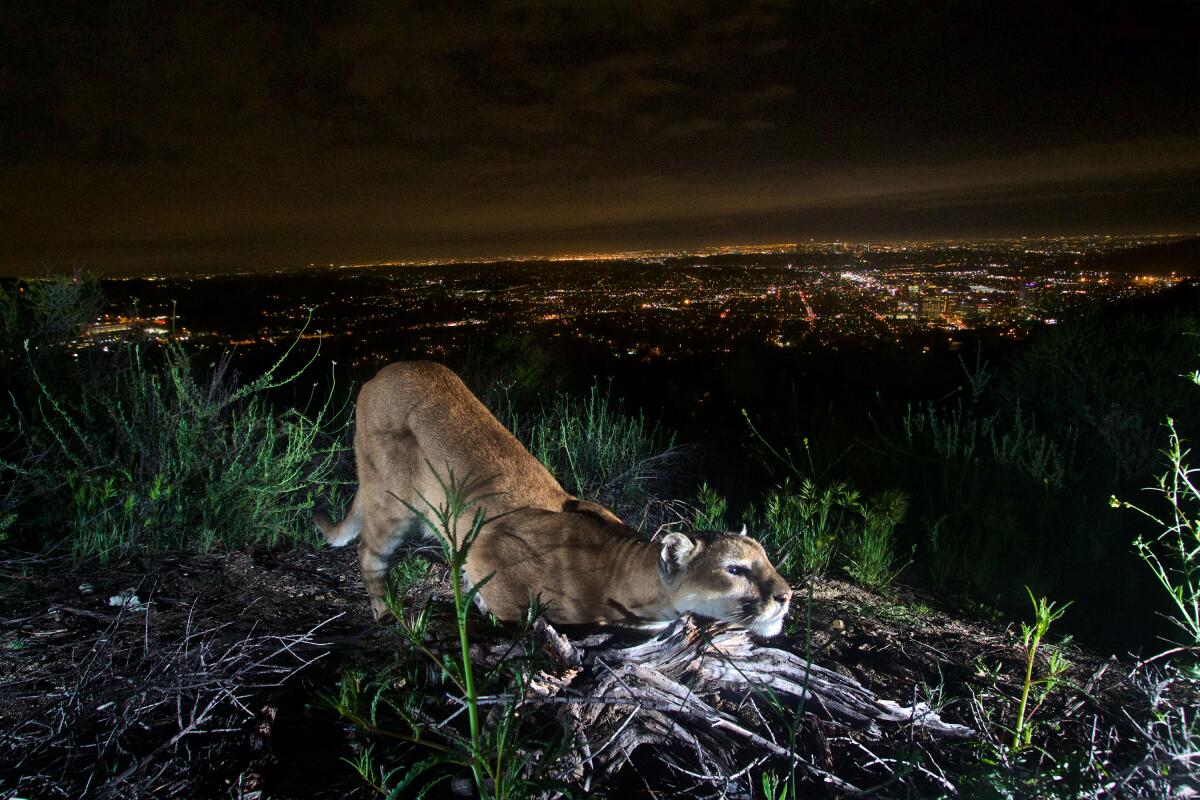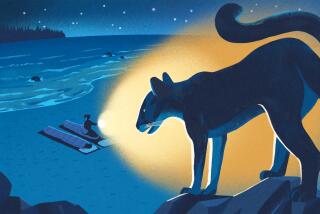Humans are the greatest peril to mountain lions. Can that change?

- Share via
Vehicle strikes. Rat poison. Permitted killings by ranchers and homeowners. The average California mountain lion is more likely to die at the hands of a human than of natural causes.
Yet new research suggests that the charismatic cats may face less risk from humans in counties where voters supported “pro-environment” ballot measures — an indication that human attitudes can play a role in survival rates.
In the first long-term, statewide analysis of mountain lion mortality, researchers examined records for 590 radio-collared cats from Siskiyou to San Diego counties, between 1974 and 2020. Of 263 documented deaths, researchers were able to determine a cause for 199. Slightly more than half of the deaths were caused by humans.
To the researchers’ surprise, the highest mortality rates due to humans did not occur in traffic-laden metropolises or agricultural areas, where pumas and livestock owners endure a tense relationship. The most dangerous areas for mountain lions are regions the researchers classified as having an “intermediate human presence,” or rural areas with a lower density of development. These include parts of the Peninsular and Transverse mountain ranges in Southern California, as well as on the Central Coast and in the Sierra Foothills.
In some of California’s most densely populated areas, such as Los Angeles and the San Francisco Bay Area, cougars saw the highest survival rates over the study period. This safety net may stem from an unlikely source: public opinion.
A common cause of death of mountain lions is so-called depredation killings, in which individuals apply to the state for permission to kill a cat responsible for the death of livestock or other domestic animals. But a livestock killing doesn’t always lead to a death sentence for the culprit. The authors wondered why.
“We had the idea that, ‘OK, well, there’s not annual ballots on whether mountain lions are good or bad, but in most years, there’s something to do with the environment,” said John Benson, a wildlife ecologist at the University of Nebraska-Lincoln and the study leader.
To tackle the question — albeit indirectly — Benson and colleagues compiled election results for California propositions related to environmental issues such as watershed conservation, greenhouse gas emissions, plastic grocery bags and a bond measure for parks and other projects. They found that regional support for these initiatives were an even better predictor of mountain lion survival than the density of goat and sheep farms, where the carnivores are more likely to enter into conflict with humans.
“We definitely understand that voting records on environmental issues don’t fully capture the complex views that people have about large carnivores, or their tolerance of them,” Benson said.
While the study authors discovered a correlation between declining mortality rates and election results, further research was necessary to prove a clear link, they said. Benson hopes ecologists and social scientists will be encouraged to investigate more directly how human attitudes and perceptions affect the survival of large carnivores.
The study, published in the journal Proceedings of the National Academy of Sciences, pulled together data and researchers from almost a dozen mountain lion research projects across the state, providing a big-picture look at mountain lion mortality and survival in California.
The research did not take into account reproduction rates or animals’ movement between regions, an important next step to see where in the state their populations may be increasing, declining or stable, Benson said.
In a state as vast and diverse as California, threats to mountain lions abound. While depredation killings, vehicle strikes, poaching and rodenticide poisoning account for the majority of deaths, mountain lions face lethal perils in the wild as well. Young cats in particular are vulnerable to starvation, illness and predation by other animals, including unrelated adult male cougars.
A recent UC Davis report tallied 535 deaths between 2015 and 2022. Although the annual rate is decreasing, it still amounts to one to two cats each week, scientists said. (That analysis relied on counts from a number of state agencies and UC researchers, which included both collared and uncollared animals. The new research examined mountain lions tracked by local wildlife agencies.)
Large freeways, especially in Southern California, have fragmented puma habitat, trapping populations to their local mountains and restricting gene flow critical to the species’ survival.
But there are signs that policies geared toward protecting the animals — or people’s attitudes toward them — are improving the situation. In the last two decades, the number of deaths by depredation has declined.
That could be for a number of reasons, such as improved attitudes toward the cats and recent protections for those living in the Santa Monica and Santa Ana mountains. In 2017, California enacted a “three-strikes” policy that requires those seeking to eradicate a problematic puma to attempt two nonlethal deterrents before resorting to lethal measures.
In 2020, the measure was expanded to protect cougars from Southern California and up the coast to the San Francisco Bay Area. In this swath of the state, mountain lions are listed as a candidate species under the California Endangered Species Act. While wildlife officials review the proposal to protect the species, the animals are considered protected under the law. A statewide ban on hunting mountain lions has been in effect since 1990.
In recent years, wildlife officials and advocates have increasingly focused on preventing human-cougar conflict.
The Cougar Conservancy, a Los Angeles-based nonprofit founded by wildlife biologist Korinna Domingo, offers education and training to help Californians avoid negative interactions with the carnivores on their properties. Among other services, the organization advises homeowners on how to build cougar-proof animal enclosures and, in the event of conflict, how to resolve it peacefully.
“We are getting better at supporting communities in living with wildlife, because we’re not just defaulting to that lethal management decision,” Domingo said. “Coexistence is the future.”
In the Santa Monica Mountains, ingestion of anticoagulant rodenticides and vehicles remains a large source of deaths. But in recent years, only one lion has been killed due to depredation — a reflection of people’s attitudes, said Seth Riley, a National Park Service wildlife ecologist and a co-author of the study.
“I think we are fortunate here in Southern California that people have relatively positive feelings about wildlife, and that extends all the way, fortunately, to mountain lions,” Riley said. “P-22 is sort of an extreme example of that: how interested and connected people ended up feeling to that individual animal.”
For a decade, P-22 lived among Angelenos in Griffith Park, a 6.5-square-mile habitat — tiny for an adult male mountain lion. In the Santa Monicas, adult males typically occupy 150 square miles.
“He showed what’s possible for wildlife and that even a large carnivore can survive and coexist for a long time in an urban area,” Riley said.







